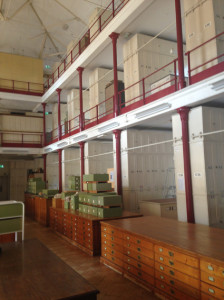State Herbarium Weeds Botanist Chris Brodie recently visited the African grass specialist Tom Cope at the Herbarium of the Royal Botanic Gardens, Kew, London, while on holiday in England. Chris had previously sent some lovegrass (Eragrostis) specimens from Adelaide to Kew that could not be reliably identified to species level using the Australian literature. Specimens sent were plants first noticed by Natural Resources (NRM) staff from Adelaide & Mount Lofty Ranges, the South East & Eyre Peninsula regions as well as plants from SA Murray-Darling Basin region.
The unknown plants turned out to be a part of the Eragrostis curvula (Schrad.) Nees complex, also commonly known as African lovegrass, a declared plant under the Natural Resources Management Act 2004.
African grass specialist Tom Cope said that this species is very variable in habit and he was certain that “this can be nothing else other than E. curvula“.
Chris said “the time spent in Kew and knowledge gained there has greatly improved our understanding of the variability that exists within this taxon in South Australia. To identify this grass, we know now to only look for the hard rigid base with many dense long hairs and at flower characters. All other features of the plant, such as stem thickness, branching, height, general habit and colour, can vary so much that superficially different races of this grass can even look like different species when side by side”.
Tom Cope also confirmed the identity of Eragrostis trichophora Coss. & Durieu, within the species complex he is calling Eragrostis cylindriflora Hochst. These plants were collected just north of Adelaide and to the west of Eyre Peninsula. The first Herbarium record for Eragrostis trichophora in South Australia dates from mid-2012 from the Eyre Peninsula.
Chris is currently working on a fact sheet for identifying Eragrostis curvula and a paper on the weedy Eragrostis taxa and their variability in South Australia. Until then, as usual, please contact Chris regarding weedy plant identification.


